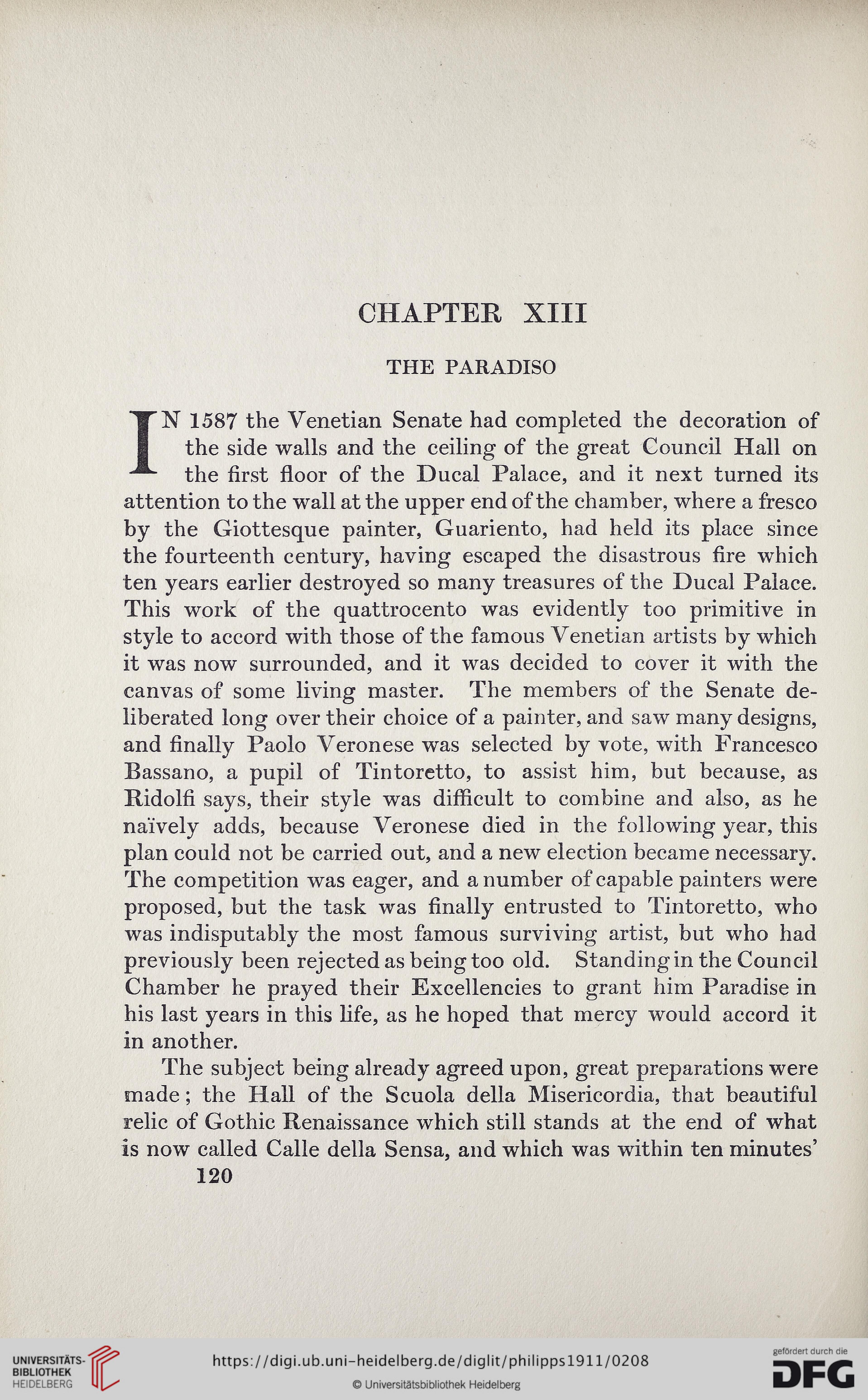CHAPTER XIII
THE PARADISO
IN 1587 the Venetian Senate had completed the decoration of
the side walls and the ceiling of the great Council Hall on
the first floor of the Ducal Palace, and it next turned its
attention to the wall at the upper end of the chamber, where a fresco
by the Giottesque painter, Guariento, had held its place since
the fourteenth century, having escaped the disastrous fire which
ten years earlier destroyed so many treasures of the Ducal Palace.
This work of the quattrocento was evidently too primitive in
style to accord with those of the famous Venetian artists by which
it was now surrounded, and it was decided to cover it with the
canvas of some living master. The members of the Senate de-
liberated long over their choice of a painter, and saw many designs,
and finally Paolo Veronese was selected by vote, with Francesco
Bassano, a pupil of Tintoretto, to assist him, but because, as
Ridolfi says, their style was difficult to combine and also, as he
naively adds, because Veronese died in the following year, this
plan could not be carried out, and a new election became necessary.
The competition was eager, and a number of capable painters were
proposed, but the task was finally entrusted to Tintoretto, who
was indisputably the most famous surviving artist, but who had
previously been rejected as being too old. Standing in the Council
Chamber he prayed their Excellencies to grant him Paradise in
his last years in this life, as he hoped that mercy would accord it
in another.
The subject being already agreed upon, great preparations were
made; the Hall of the Scuola della Misericordia, that beautiful
relic of Gothic Renaissance which still stands at the end of what
is now called Calle della Sensa, and which was within ten minutes’
120
THE PARADISO
IN 1587 the Venetian Senate had completed the decoration of
the side walls and the ceiling of the great Council Hall on
the first floor of the Ducal Palace, and it next turned its
attention to the wall at the upper end of the chamber, where a fresco
by the Giottesque painter, Guariento, had held its place since
the fourteenth century, having escaped the disastrous fire which
ten years earlier destroyed so many treasures of the Ducal Palace.
This work of the quattrocento was evidently too primitive in
style to accord with those of the famous Venetian artists by which
it was now surrounded, and it was decided to cover it with the
canvas of some living master. The members of the Senate de-
liberated long over their choice of a painter, and saw many designs,
and finally Paolo Veronese was selected by vote, with Francesco
Bassano, a pupil of Tintoretto, to assist him, but because, as
Ridolfi says, their style was difficult to combine and also, as he
naively adds, because Veronese died in the following year, this
plan could not be carried out, and a new election became necessary.
The competition was eager, and a number of capable painters were
proposed, but the task was finally entrusted to Tintoretto, who
was indisputably the most famous surviving artist, but who had
previously been rejected as being too old. Standing in the Council
Chamber he prayed their Excellencies to grant him Paradise in
his last years in this life, as he hoped that mercy would accord it
in another.
The subject being already agreed upon, great preparations were
made; the Hall of the Scuola della Misericordia, that beautiful
relic of Gothic Renaissance which still stands at the end of what
is now called Calle della Sensa, and which was within ten minutes’
120




